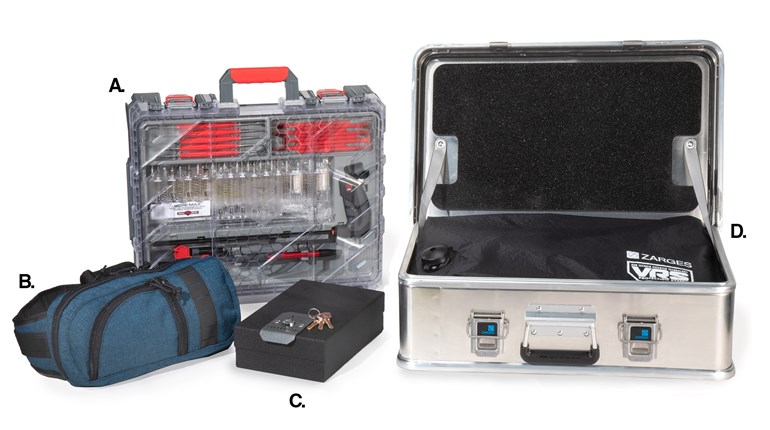
This week we begin “First Gear” with an optic that’s easy to place near the top of our current “yee haw!” continuum. The name is certainly well known—EOTech—and the company’s traditional game follows suit: super-tough holographic-reticled 1x optics that were widely used in a host of LE, military and civilian applications. Popular, rugged and well-suited to a host of difficult jobs, the last year or so has been tough on a carefully burnished reputation. Still, EOTech and parent L3 Communications can hardly be accused of not stepping up under difficult circumstances.
To this we have two things to add. First, when it comes to our own EOTechs (note plural), we’re keepin’ ‘em. Particularly on the likes of a carbine, they have few peers when used as spec’d.Particularly on the likes of a carbine, they have few peers when used as spec’d.

Second, we don’t think the current rough patch will continue when shooters of many stripes get a squint at the Vudu 1-6x24 and its kin. Back to that “yee haw,” in others words.
Our Vudu hosts a bunch of current “gotta haves” for many shooters, and first focal plane is a big one. Second focal plane systems are actually more familiar. Here, changing magnification does precisely what you’d expect—zooms the target view larger or apparently closer as power increases, and smaller/apparently further as the power number falls. Target view has the appearance of changing underneath or behind a crosshair.
First focal plane (FFP) systems zoom the reticle with the view, and so represent a relatively major departure. Both have their proponents and advantages. But while FFPs obscure some of the target with reticle as the power grows, they simplify windage or elevation corrections: “Dopes” are the same no matter the power.

Where the Vudu gets clever is in combining an EOTech-style reticle with magnifying optics (other reticles are available, however). Part of what rightly made the holosights popular and effective was a large (68 minute-of-angle) circle that works extremely well with the eye/brain concentricity bias. On close targets, this means centering is very rapid, and—with a little practice—allows shots that reliably hit very close the center of mass of a target. On more distant targets, the circle has ranging utility. A small central dot gives surprising precision as far out as 300 yards.
Crank up the magnification on the new Vudu, however, and you’ll watch that big circle grow, sliding progressively outward and eventually out of the field of view. What was a small dot is now an impressively sharp circle with a 1.5 MOA (.44 MIL) dot and ballistic drop compensation stadia graduated out to 600 yards. We grant it takes a little getting used to, but in our test “vehicle” for the Vudu (a four-caliber Windham Weaponry rifle), we produced several groups at just over half-a-minute of angle. Differing ballistics imply that the drops won’t correspond precisely as indicated, but that’s a math problem, not a scope issue. From 9 mm through 5.56 to .300 AAC and 7.62x39, performance was excellent.
Our taste for the Vudu hardly stops with FFP. In a phase where some parts of our industry are losing sight—at least a little—of the importance of realistic weight, we approve of the 30 mm tube. Yes, a 34 will allow for bigger lenses and a little more light, but we had to shoot some test groups indoors with the 1-6x. We found it plenty bright in these normally darkish confines, so the weight savings captured by going with a smaller tube seems eminently worthwhile.We found it plenty bright in these normally darkish confines, so the weight savings captured by going with a smaller tube seems eminently worthwhile.
The Vudu also features excellent controls all around. The power change ring is about the grippiest we know of, and perhaps the coolest-looking as well. Unlike some competitors with smallish targets for this crucial adjustment, you can grab the Vudu ring nearly anywhere along its expanse, and crank with authority. Not enough? A screw-in throw lever is supplied, so expect 3-gunners to approve as well. Windage and elevation are much the same—positive and readable (this latter is a dopey failing in others for which there really is no excuse). Illumination of the reticle is clever, too; on/off is distinct from up and down, and positioned so hat or other head gear isn’t doomed to collision after collision, which jostles (or annoys) you “out” of the scope and your cheek weld.
But perhaps we’ve said enough. We can think of about a dozen rifles and calibers that could make good use of a EOTech Vudu 1-6x24 (or take a look at the 2.5-10x or 3.5-18x if you need more magnification). Meanwhile, we’re sort of hoping the EOTech folks will forget where this one is for a little while longer.
Cantilever Mount
Our 1-6x24 Vudu arrived so fresh from EOTech it was in a “plain brown wrapper,” so to speak—quite literally a box with nothing but a hand-printed declaration of contents. That’s a solid hint that it was very early production. Even more, well, primitive was packaging of the accompanying cantilever/QD mount scaled to the 30mm tube—an unlabeled plastic bag. Don’t misunderstand us here—we actually prefer to get review gear so obviously on the front of the production curve.
But the mount itself was nothing like primitive. As with the Vudu (or any other 30 mm) it cradles, a very close eye has been kept on structures or dimensions that add weight, but not capability. While it remains a good-looking mount to our eye, no quarter-ounces here or there have been wasted on cosmetics alone. Scope capture/retention is two horizontally split “rings” and closure with Torx screws (wrench provided, though we always recommend this driver from Brownells for proper tension).While it remains a good-looking mount to our eye, no quarter-ounces here or there have been wasted on cosmetics alone.
The slickest aspect of the mount comes to light when rail attachment time rolls around. Clever engineering is one thing, but over-engineering quite another, yet the latter has been avoided to such an extent that the QD EOTech hardly needs instructions. Everybody knows that Picatinny rails—despite being carefully spec’d—simply aren’t the same. The adjustment to overcome this, a comparatively complex mess on others we could name, is tool-less and obvious on the EOTech mount: Push this-a-way, turn that-a-way (righty-tighty, lefty-loosey), and done.
“Locking” mechanics are another pleaser, though it takes a discerning eye to see why. While EOTech holosights always had good latching and locking for their integral mounts, small changes are evident in their application to the QD. We’d say it’s noticeably better—in the sense of seeing immediately how it operates as well as operation itself—and all but foolproof. Instructions? Again, pffffft!
Suffice it to say we’ll be waiting in line for at least one of these when they’re available. Funny thing, though: The last time we talked with EOTech, they were a little shy about the name and part number that corresponds to this superb mount.
All we can say is “get one”: a part number, we hope, from EOTech, and an order in from us.
Visit EOTech at eotechinc.com.


































